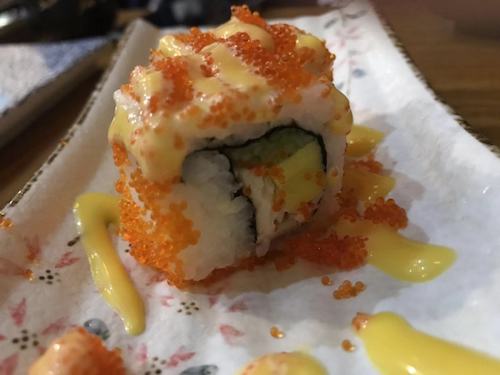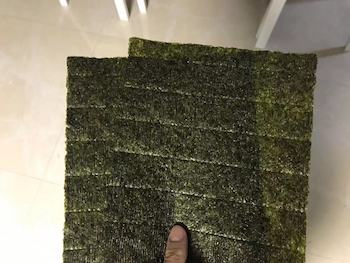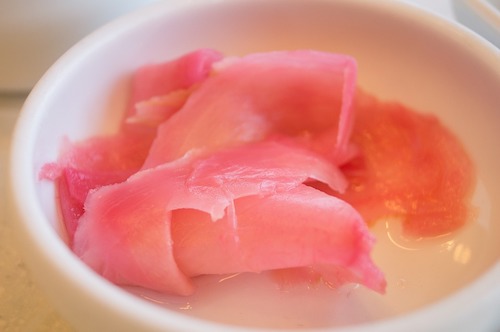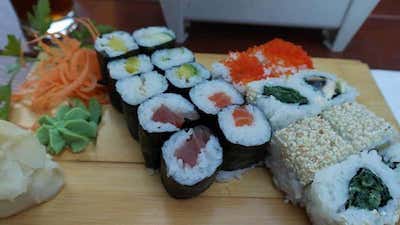We are reader supported. When you purchase through links on our site, we may earn an affiliate commission. Also, as an Amazon affiliate, we earn from qualifying purchases.

If you are a beginner at sushi eating, I don’t blame you for thinking that sushi is a gluten-free meal. After all, it contains just rice, fish, and vegetables. Where’s gluten got to do with it? Those who are allergic to gluten or have gluten-sensitivity have no reason to worry, or do they?
Does sushi have gluten? Sorry to break the bubble, but yes! The seemingly safe sushi meal may not be gluten-free because there are various sources from which gluten stealthily creeps into it. Soy sauce, for example, has wheat and surimi may contain wheat starch.
The vinegar used for seasoning sushi rice and condiments like wasabi may also contain gluten, though not always. Furthermore, sushi containing marinated ingredients, fish or vegetable tempura is also laden with lots of gluten.
Contents
Sushi and Gluten: A Love-Hate Relation!
I have many friends who are oblivion of the fact that sushi can contain gluten and when I tell them, they are shocked like hell. If you are feeling something similar, like all the hell has broken loose on you, breathe easy.
While sushi, which apparently looks like a gluten-free meal, does have the dreaded evil in hiding in numerous traps, there are ways to avoid them. If you must have sushi while dining out, the trick is to order safely and enjoy a meal that suits a celiac diet
Let the chef know that you have non-celiac gluten sensitivity, and request him to avoid specific ingredients that may contain gluten. A good idea is to call a restaurant beforehand to inquire how the meal is prepared and if they can accommodate special dietary requirements for a gluten-free meal.
However, let me warn you that this is not a fool-proof method because the risk of cross-contamination still lingers around. If the restaurant makes a lot of tempuras and uses rice vinegar excessively, gluten may accidentally creep into your food. The possibility of contamination is also high if the chef uses the same utensils and knives.
If you are extremely allergic, you need to be really firm in your communication with the sushi chef. Tell him to avoid any contact with sauces or marinades while making your order. You may also request him to use a clean knife and other utensils.
To be on the safe side, you may bring your own gluten-free soy sauce and wasabi to go with your sushi meal. Good news is that many restaurants in Japan now stock gluten-free soy sauce. While it’s comparatively easier to get a safe and gluten-free sushi meal at restaurants, it’s not the same in case of supermarket or grocery store sushi so they must be avoided at all cost.
Types Of Sushi That Contains Gluten
Sushi should typically be gluten-free and I would like to believe that they were so in their nascent stage several hundred years ago. However, the heavy western influence and dramatic evolution of this humble Japanese delicacy have included certain items that were earlier not a part of the meal.

The inside-out sushi, also California rolls (especially the ones available for takeaway in outlets) contain fake crab or surimi instead of real crab meat. Now, surimi is an imitation crab cake made from ground white fish meat, especially Pollock fish and mixing it with starch, eggs, and other flavorings.
While the surimi looks like a harmless and quick to use crab stick for a delicious sushi meal at home, the ‘starch and other ingredients’ mentioned in the package puts California rolls in the ‘avoid list’. You must stay away from this style of sushi unless it is specifically mentioned that it contains gluten-free ingredients.
When asking a restaurant to take a gluten-free order, make sure the chef knows that surimi contains wheat. Order a simple and single ingredient roll. If you do order a multi-ingredient roll, never take a chance on imitation crab meat unless you are 100% sure that it’s gluten-free.
Besides surimi, you must also be careful about the tempura style sushi, such as shrimp tempura roll and deep-fried sushi. You sushi may also contain tempura-dipped meats and vegetables, so ask your chef to completely avoid it. The tempura batter typically contains wheat flour, which is a strict no.
Luckily, the tempura sushi rolls are easy to identify as they are fried and coated. Hence, there’s no chance of you unknowingly consuming gluten. There are some restaurant that use gluten-free batter to make tempura but that is rare and their food is boldly labeled as ‘gluten-free’.
Sushi Containing Marinated Ingredients Is Not Gluten-Free
There is a lot of confusion between what is gluten and what is not, and marinated items are one of them. Some sushi recipes may contain marinated seafood or fish, such as unagi (freshwater eel), tuna, and salmon. The marinades typically contain teriyaki sauce or soy sauce that contains starch.
Most of the sauces contain wheat, hence they are not gluten-free. If you are looking for a gluten-free meal, you should stay away from sushi that contains sauce or marinade, unless you are doubly sure that it’s made of gluten-free sauce.

You should also watch out for the green paste called wasabi that can make your sinuses go wild and give you sushi meal a real punch. However, most restaurants in the US do not use real wasabi and serve a substitute made of horseradish, green food coloring, mustard and fillers that may contain gluten.
To prevent any health risks, you may request the restaurant to allow you to take a look at the ingredients used in making your order. Some restaurants will willingly agree if you politely state your health-concerns without being bossy. If you are going to make real wasabi at home, you can have a look at my previous article.
Gluten Risk In Main Ingredients Used In Sushi
#1.Sushi Rice
If your body reacts adversely to the grain-based vinegars then let me warn you that the rice used in preparing sushi is always seasoned with vinegar. As specific varieties of vinegar, such as rice vinegar is derived from grains, it may contain gluten from starch.
Sushi rice gets its unique taste and flavor only after it is properly seasoned with rice vinegar solution mixed with sugar and salt. If you are making sushi at home, I would suggest that you buy gluten-free vinegar from the grocery store.
If you are dining out, ask the chef if he has mixed anything in the sushi rice that contains gluten. In case, he uses rice vinegar, requests him to use plain rice for making your order. Although unseasoned rice cannot make a neat roll, most sushi chefs will agree.
In some restaurants, they may add chicken broth to sushi rice and thus add gluten to it. This is another reason why you must ask in advance.
#2. Seaweed or Nori sheets

That dark green covering you see outside your favorite sushi is made from seaweed and it is called Nori. Technically, they comprise of edible red algae that are processed via a shredding and drying method which is quite similar to the art of papermaking.
Salt and oil may be added to the mixture in order to enhance the flavor. Thus, the original Nori used in sushi is gluten free and safe for consumption. However, make sure there are no additional flavors like teriyaki or soy sauce added to the product. The Korean Nori is often flavored, thus not gluten-free.
#3. Fillings Used In Sushi
Raw fillings such as sushi-grade fish, seafood, cucumber, avocado, and other vegetables are typically free of gluten. You must avoid fillings that are fried using a tempura batter, cooked or marinated with soy sauce.
Some other ingredients such as Japanese mayo, cream cheese, and sesame seeds are also gluten-free unless they are cross-contaminated. Beware of items like imitation crab meat or surimi. Real crab is safe but surimi is not.
#4. Wasabi

Real wasabi paste comes from grating the stem or rhizome of wasabi plant found in Japan. In its original form, wasabi is absolutely gluten-free. However, the fate of wasabi is such that most customers are served the fake substitute made from horseradish, mustard, starch and green color.
The reason behind this is high price and rare availability of real wasabi stem. To save money, most restaurants and manufacturers serve/ sell wasabi paste that may not contain the real thing. As a result, you must be extra cautious about what you eat and always check the ingredients mentioned in the package when buying readymade wasabi.
While wasabi is typically served as a side condiment along with your sushi and sashimi, some chefs may put some wasabi between sushi rice and fish. So, if you are extremely sensitive to gluten, you don’t only need to avoid the sauce served along with your meal, but also tell the chef to not put any wasabi in your nigiri or sushi roll.
#5. Sauces
The sauces served with sushi are the real evil when it comes to increasing the gluten parameter. Some of the common sauces served with sushi in the restaurants are teriyaki sauce, soy sauce, and barbeque sauce often served with sushi rolls containing eel.
No matter how tempting the sauces appear, make sure you always ask the chef what ingredients are used in preparing them. The rule of thumb is to skip any sauce that you are not 100% sure to be gluten-free. There are a lot of gluten-free sauces available online and you may consider carrying your own sauce when dining out at a sushi restaurant.
Tamari is a safer option for those who looking for sushi dipping sauce. It is also made from fermented soybeans and is similar in taste. However, it does not contain wheat that is usually found in soy sauce alongside fermented soybeans, water, and salt. As a result, tamari is considered as a good alternative for a celiac diet.
#6. Pickled Ginger

Pickled ginger (gari) is the slight pink thing you see on your sushi plate. Its role is to cleanse your palate so that you can enjoy the subtle flavors of different species of fish. However, some manufacturers may use barley-based vinegar to pickle young ginger roots, thus it is not entirely gluten-free. To be on the safe side, always check the brand and read the ingredients before buying.
Gluten-Free Sushi Recipe
I hope the above information guides you on how to stay safe when dining out at a sushi restaurant. If you find yourself persistently worrying about ‘does sushi have gluten’ when eating out, I suggest cutting the risk completely by making your own gluten-free sushi at home. Here’s the recipe for you:
What you will need:
- Nori sheets
- Sushi rice
- 1 ripe but firm Avocado
- 1 ripe but firm mango
- 1 Japanese cucumber
- 2 oz sushi-grade fish – tuna (maguro) or salmon (sake)
- Gluten-free Tamari soy sauce
- Sesame seeds
- Gluten-free teriyaki
- Gluten-free Pickled Ginger and wasabi
Instructions
Prepare sushi rice using short grain Japanese rice. I have created an article on how to cook perfect sushi rice in a pot and cooker. Season your rice only if you have rice vinegar that has gluten free written on it.
Or, you may simply avoid the seasoning part and use plain rice for this recipe. Just mix some sesame seed to enhance the taste.
Peel avocado and mango, cut into equal-sized strips, Julienne cucumber to prepare the fillings
Place the bamboo sushi mat on a plain surface and keep the Nori sheet on it, shiny side down.
Take a spoon of sushi rice and spread it over the Nori sheet, leaving a one-inch gap on all sides
Arrange the sushi fillings, first tuna or salmon strips, then avocado, mango, and cucumber, on the rice towards you
Lift the bamboo mat from the side closest to you and start rolling. Press gently to get a compact roll while keeping the fillings intact.
When you are done, give one tight squeeze using the bamboo mat and now place the sushi roll on a dry cutting board
Take a sharp Japanese knife like this, cut the roll first into half and then into 6-8 equal pieces. Now enjoy your sushi with gluten-free sauces.
Related Questions
Is miso soup gluten-free?
This delicious soup is made of fermented soybeans and different types of grains that include gluten-laden barley. If you wish to avoid gluten from your diet, you must ask for or make miso soup using gluten-free grains.
Related Article: Is Eel Sauce Gluten Free?
What is the risk of cross-contamination
You may tell your chef to prepare gluten-free sushi but what if he uses the same surface for cutting ingredients and the same knife he used for cutting gluten-containing foods. This could lead to cross-contamination and the entire purpose of ordering a special diet becomes void. So, while dining out, make sure the chef is careful enough to not cause cross-contamination.
Is Flying Fish Roe or Tobiko safe for a celiac diet
If you are gluten-sensitive, I would recommend you to avoid flying fish roe or tobiko as they contain soy sauce. Most of the fish eggs used in sushi are synthetic in nature. Real fish roe and caviar are gluten-free but remember to ask before you order.
Are there gluten-free restaurants in California
My two favorite California sushi joints that serve gluten-free food are Mizu located in San Jose, CA and Sushi Confidential restaurant in Campbell, California.
You may also want to see:
Does Sushi Count As Fast Food?
(Gimbap) Kimbap vs Sushi Detailed Explanation
What Is Oba In Sushi? Read This First!
Can you make Sushi without Rice Vinegar?

